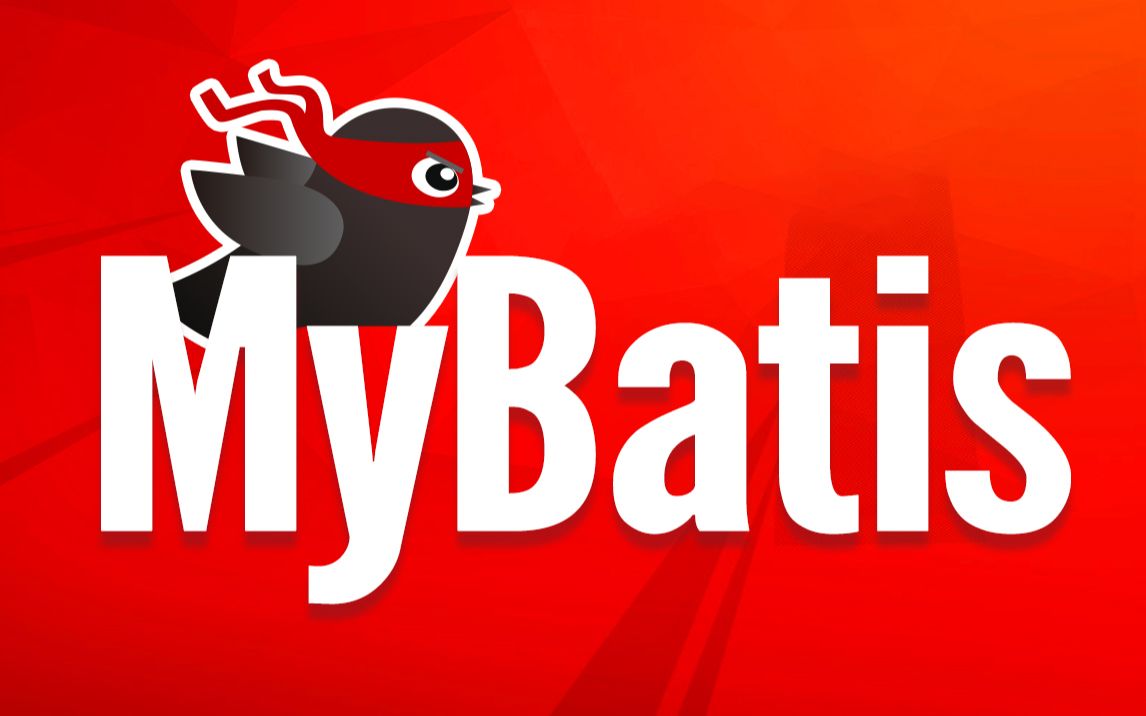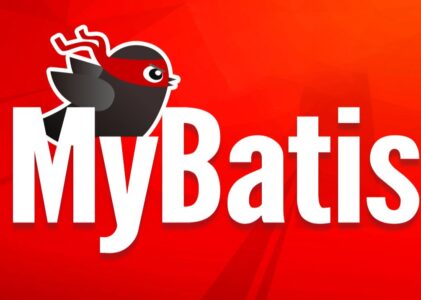后端程序开发人员,通常会使用Java程序来完成对数据库的操作。Java程序操作数据库,现在主流的方式是:Mybatis。
什么是MyBatis?
- MyBatis是一款优秀的 持久层框架,用于简化JDBC的开发。
- MyBatis本是 Apache的一个开源项目iBatis,2010年这个项目由apache迁移到了google code,并且改名为MyBatis 。2013年11月迁移到Github。
- 官网:https://mybatis.org/mybatis-3/zh/index.html
在上面我们提到了两个词:一个是持久层,另一个是框架。
- 持久层:指的是就是数据访问层(dao),是用来操作数据库的。

- 框架:是一个半成品软件,是一套可重用的、通用的、软件基础代码模型。在框架的基础上进行软件开发更加高效、规范、通用、可拓展。
快速入门
需求:使用Mybatis查询所有用户数据。
入门程序分析
以前我们是在图形化客户端工具中编写SQL查询代码,发送给数据库执行,数据库执行后返回操作结果。图形化工具会把数据库执行的查询结果,使用表格的形式展现出来。
现在使用Mybatis操作数据库,就是在Mybatis中编写SQL查询代码,发送给数据库执行,数据库执行后返回结果。

Mybatis会把数据库执行的查询结果,使用实体类封装起来(一行记录对应一个实体类对象)

Mybatis操作数据库的步骤:
- 准备工作(创建springboot工程、数据库表user、实体类User)
- 引入Mybatis的相关依赖,配置Mybatis(数据库连接信息)
- 编写SQL语句(注解/XML)
入门程序实现
创建springboot工程,并导入 mybatis的起步依赖、mysql的驱动包。


创建用户表user,并创建对应的实体类User。
- 用户表
-- 用户表
create table user(
id int unsigned primary key auto_increment comment 'ID',
name varchar(100) comment '姓名',
age tinyint unsigned comment '年龄',
gender tinyint unsigned comment '性别, 1:男, 2:女',
phone varchar(11) comment '手机号'
) comment '用户表';
-- 测试数据
insert into user(id, name, age, gender, phone) VALUES (null,'白眉鹰王',55,'1','18800000000');
insert into user(id, name, age, gender, phone) VALUES (null,'金毛狮王',45,'1','18800000001');
insert into user(id, name, age, gender, phone) VALUES (null,'青翼蝠王',38,'1','18800000002');
insert into user(id, name, age, gender, phone) VALUES (null,'紫衫龙王',42,'2','18800000003');
insert into user(id, name, age, gender, phone) VALUES (null,'光明左使',37,'1','18800000004');
insert into user(id, name, age, gender, phone) VALUES (null,'光明右使',48,'1','18800000005');- 实体类
- 实体类的属性名与表中的字段名一一对应。
public class User {
private Integer id; //id(主键)
private String name; //姓名
private Short age; //年龄
private Short gender; //性别
private String phone; //手机号
//省略GET, SET方法
}
配置Mybatis
在之前使用图形化客户端工具,连接MySQL数据库时,需要配置:
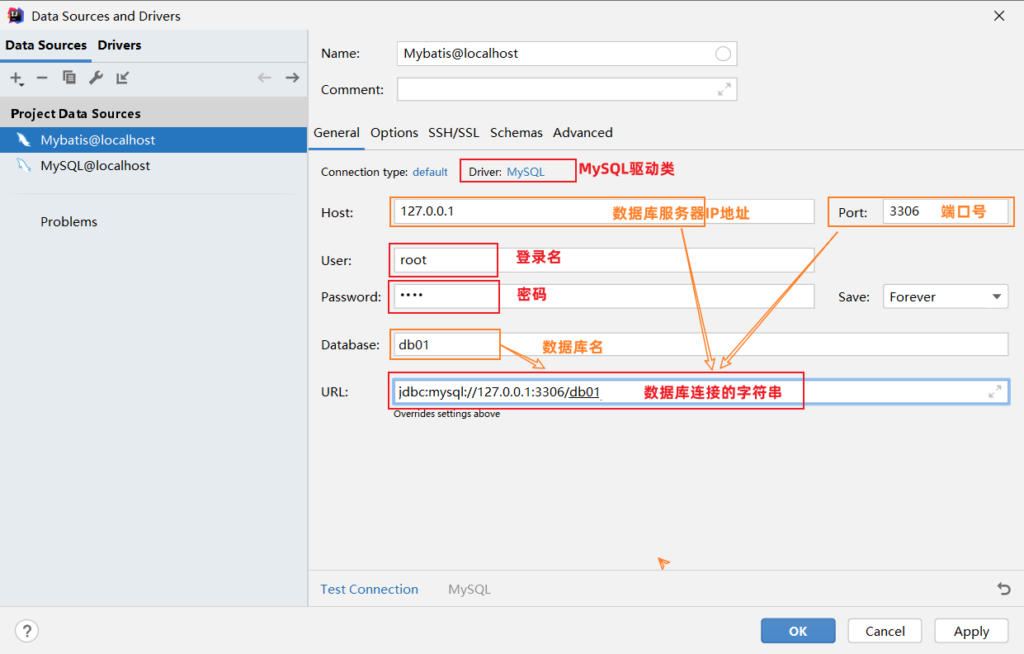
连接数据库的四大参数:
- MySQL驱动类
- 登录名
- 密码
- 数据库连接字符串
基于上述分析,在Mybatis中要连接数据库,同样也需要以上4个参数配置。
在springboot项目中,可以编写application.properties文件,配置数据库连接信息。我们要连接数据库,就需要配置数据库连接的基本信息,包括:driver-class-name、url 、username,password。
application.properties:
#驱动类名称
spring.datasource.driver-class-name=com.mysql.cj.jdbc.Driver
#数据库连接的url
spring.datasource.url=jdbc:mysql://localhost:3306/mybatis
#连接数据库的用户名
spring.datasource.username=root
#连接数据库的密码
spring.datasource.password=123456编写SQL语句
在创建出来的springboot工程中,在引导类所在包下,在创建一个包 mapper。在mapper包下创建一个接口 UserMapper ,这是一个持久层接口(Mybatis的持久层接口规范一般都叫 XxxMapper)。

import com.itheima.pojo.User;
import org.apache.ibatis.annotations.Mapper;
import org.apache.ibatis.annotations.Select;
import java.util.List;
@Mapper
public interface UserMapper {
//查询所有用户数据
@Select("select id, name, age, gender, phone from user")
public List<User> list();
}@Mapper注解:表示是mybatis中的Mapper接口
- 程序运行时:框架会自动生成接口的实现类对象(代理对象),并给交Spring的IOC容器管理
@Select注解:代表的就是select查询,用于书写select查询语句
单元测试
在创建出来的SpringBoot工程中,在src下的test目录下,已经自动帮我们创建好了测试类 ,并且在测试类上已经添加了注解 @SpringBootTest,代表该测试类已经与SpringBoot整合。
该测试类在运行时,会自动通过引导类加载Spring的环境(IOC容器)。我们要测试哪个bean对象,就可以直接通过@Autowired注解直接将其注入进行,然后就可以测试了。
测试类代码如下:
@SpringBootTest
public class MybatisQuickstartApplicationTests {
@Autowired
private UserMapper userMapper;
@Test
public void testList(){
List<User> userList = userMapper.list();
for (User user : userList) {
System.out.println(user);
}
}
}运行结果:

解决SQL警告与提示
默认我们在UserMapper接口上加的@Select注解中编写SQL语句是没有提示的。 如果想让idea给我们提示对应的SQL语句,我们需要在IDEA中配置与MySQL数据库的链接。
默认我们在UserMapper接口上的@Select注解中编写SQL语句是没有提示的。如果想让idea给出提示,可以做如下配置:

配置完成之后,发现SQL语句中的关键字有提示了,但还存在不识别表名(列名)的情况:

产生原因:Idea和数据库没有建立连接,不识别表信息
解决方案:在Idea中配置MySQL数据库连接

在配置的时候连接指定的数据库,如上图所示连接的就是mybatis数据库。
JDBC介绍
通过Mybatis的快速入门,我们明白了,通过Mybatis可以很方便的进行数据库的访问操作。但其实java语言操作数据库只能通过一种方式:使用sun公司提供的 JDBC 规范。
Mybatis框架,就是对原始的JDBC程序的封装。
那到底什么是JDBC呢,接下来,我们就来介绍一下。
JDBC: ( Java DataBase Connectivity ),就是使用Java语言操作关系型数据库的一套API。
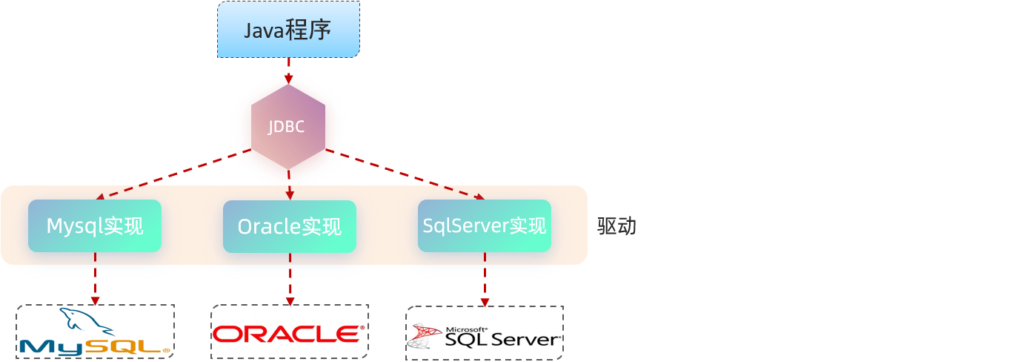
本质:
- sun公司官方定义的一套操作所有关系型数据库的规范,即接口。
- 各个数据库厂商去实现这套接口,提供数据库驱动jar包。
- 我们可以使用这套接口(JDBC)编程,真正执行的代码是驱动jar包中的实现类。
代码
下面看看原始的JDBC程序是如何操作数据库的。操作步骤如下:
- 注册驱动
- 获取连接对象
- 执行SQL语句,返回执行结果
- 处理执行结果
- 释放资源
JDBC具体代码实现:
import com.itheima.pojo.User;
import org.junit.jupiter.api.Test;
import java.sql.Connection;
import java.sql.DriverManager;
import java.sql.ResultSet;
import java.sql.Statement;
import java.util.ArrayList;
import java.util.List;
public class JdbcTest {
@Test
public void testJdbc() throws Exception {
//1. 注册驱动
Class.forName("com.mysql.cj.jdbc.Driver");
//2. 获取数据库连接
String url="jdbc:mysql://127.0.0.1:3306/mybatis";
String username = "root";
String password = "123456";
Connection connection = DriverManager.getConnection(url, username, password);
//3. 执行SQL
Statement statement = connection.createStatement(); //操作SQL的对象
String sql="select id,name,age,gender,phone from user";
ResultSet rs = statement.executeQuery(sql);//SQL查询结果会封装在ResultSet对象中
List<User> userList = new ArrayList<>();//集合对象(用于存储User对象)
//4. 处理SQL执行结果
while (rs.next()){
//取出一行记录中id、name、age、gender、phone下的数据
int id = rs.getInt("id");
String name = rs.getString("name");
short age = rs.getShort("age");
short gender = rs.getShort("gender");
String phone = rs.getString("phone");
//把一行记录中的数据,封装到User对象中
User user = new User(id,name,age,gender,phone);
userList.add(user);//User对象添加到集合
}
//5. 释放资源
statement.close();
connection.close();
rs.close();
//遍历集合
for (User user : userList) {
System.out.println(user);
}
}
}DriverManager(类):数据库驱动管理类。
- 作用:
- 注册驱动
- 创建java代码和数据库之间的连接,即获取Connection对象
Connection(接口):建立数据库连接的对象
- 作用:用于建立java程序和数据库之间的连接
Statement(接口): 数据库操作对象(执行SQL语句的对象)。
- 作用:用于向数据库发送sql语句
ResultSet(接口):结果集对象(一张虚拟表)
- 作用:sql查询语句的执行结果会封装在ResultSet中
通过上述代码,我们看到直接基于JDBC程序来操作数据库,代码实现非常繁琐,所以在项目开发中很少使用。 在项目开发中,通常会使用Mybatis这类的高级技术来操作数据库,从而简化数据库操作、提高开发效率。
问题分析
原始的JDBC程序,存在以下几点问题:
- 数据库链接的四要素(驱动、链接、用户名、密码)全部硬编码在java代码中
- 查询结果的解析及封装非常繁琐
- 每一次查询数据库都需要获取连接,操作完毕后释放连接, 资源浪费, 性能降低
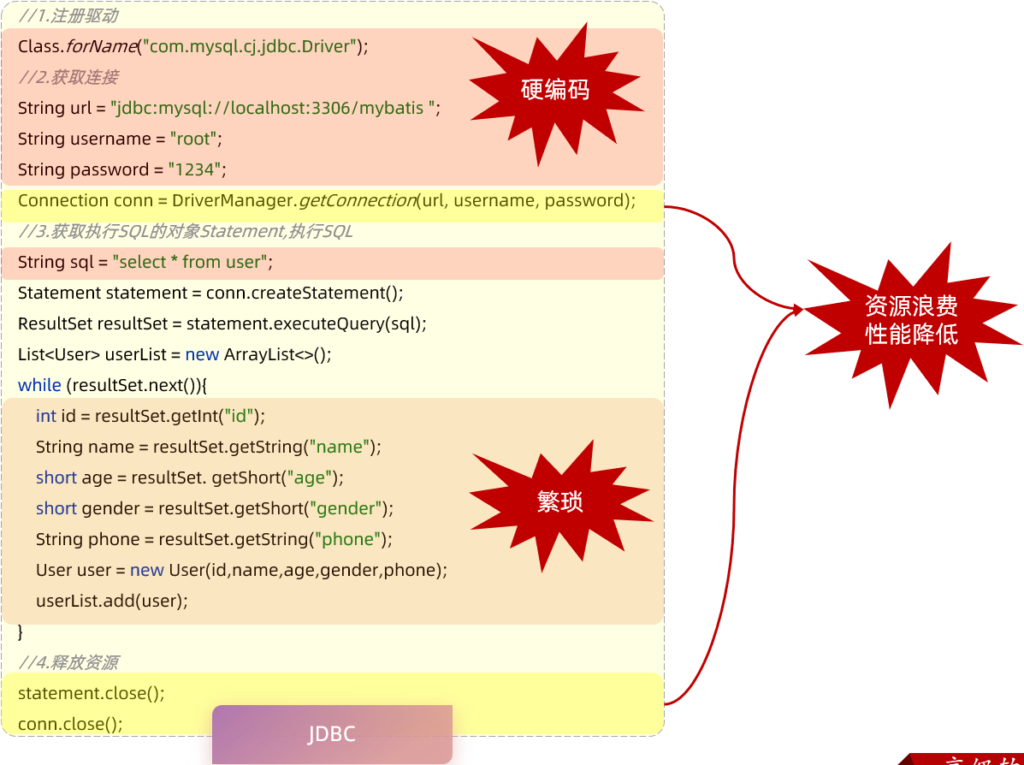
技术对比
分析了JDBC的缺点之后,我们再来看一下在mybatis中,是如何解决这些问题的:
- 数据库连接四要素(驱动、链接、用户名、密码),都配置在springboot默认的配置文件 application.properties中
- 查询结果的解析及封装,由mybatis自动完成映射封装,我们无需关注
- 在mybatis中使用了数据库连接池技术,从而避免了频繁的创建连接、销毁连接而带来的资源浪费。
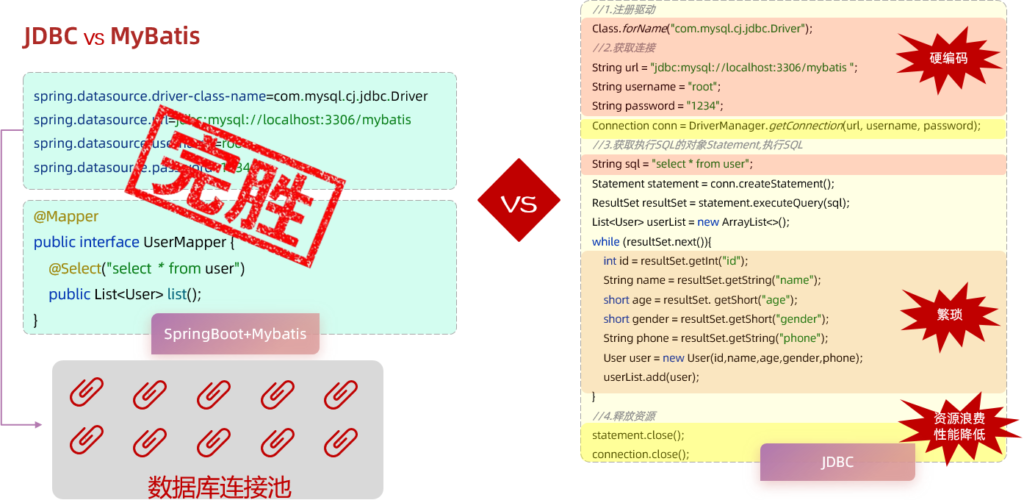
数据库连接池
在前面我们所讲解的mybatis中,使用了数据库连接池技术,避免频繁的创建连接、销毁连接而带来的资源浪费。
介绍

没有使用数据库连接池:
- 客户端执行SQL语句:要先创建一个新的连接对象,然后执行SQL语句,SQL语句执行后又需要关闭连接对象从而释放资源,每次执行SQL时都需要创建连接、销毁链接,这种频繁的重复创建销毁的过程是比较耗费计算机的性能。

数据库连接池是个容器,负责分配、管理数据库连接(Connection)
- 程序在启动时,会在数据库连接池(容器)中,创建一定数量的Connection对象
允许应用程序重复使用一个现有的数据库连接,而不是再重新建立一个
- 客户端在执行SQL时,先从连接池中获取一个Connection对象,然后再执行SQL语句,SQL语句执行完之后,释放Connection时就会把Connection对象归还给连接池(Connection对象可以复用)
释放空闲时间超过最大空闲时间的连接,来避免因为没有释放连接而引起的数据库连接遗漏
- 客户端获取到Connection对象了,但是Connection对象并没有去访问数据库(处于空闲),数据库连接池发现Connection对象的空闲时间 > 连接池中预设的最大空闲时间,此时数据库连接池就会自动释放掉这个连接对象
数据库连接池的好处:
- 资源重用
- 提升系统响应速度
- 避免数据库连接遗漏
产品
要怎么样实现数据库连接池呢?
- 官方(sun)提供了数据库连接池标准(javax.sql.DataSource接口)
- 功能:获取连接
- public Connection getConnection() throws SQLException;
- 第三方组织必须按照DataSource接口实现
- 功能:获取连接
常见的数据库连接池:
- C3P0
- DBCP
- Druid
- Hikari (springboot默认)
现在使用更多的是:Hikari、Druid (性能更优越)
- Hikari(追光者) [默认的连接池]

- Druid(德鲁伊)
- Druid连接池是阿里巴巴开源的数据库连接池项目
- 功能强大,性能优秀,是Java语言最好的数据库连接池之一
如果我们想把默认的数据库连接池切换为Druid数据库连接池,只需要完成以下两步操作即可:
参考官方地址:https://github.com/alibaba/druid/tree/master/druid-spring-boot-starter
- 在pom.xml文件中引入依赖
<dependency>
<!-- Druid连接池依赖 -->
<groupId>com.alibaba</groupId>
<artifactId>druid-spring-boot-starter</artifactId>
<version>1.2.8</version>
</dependency>- 在application.properties中引入数据库连接配置
方式1:
spring.datasource.druid.driver-class-name=com.mysql.cj.jdbc.Driver
spring.datasource.druid.url=jdbc:mysql://localhost:3306/mybatis
spring.datasource.druid.username=root
spring.datasource.druid.password=1234方式2:
spring.datasource.driver-class-name=com.mysql.cj.jdbc.Driver
spring.datasource.url=jdbc:mysql://localhost:3306/mybatis
spring.datasource.username=root
spring.datasource.password=1234lombok
介绍
Lombok是一个实用的Java类库,可以通过简单的注解来简化和消除一些必须有但显得很臃肿的Java代码。
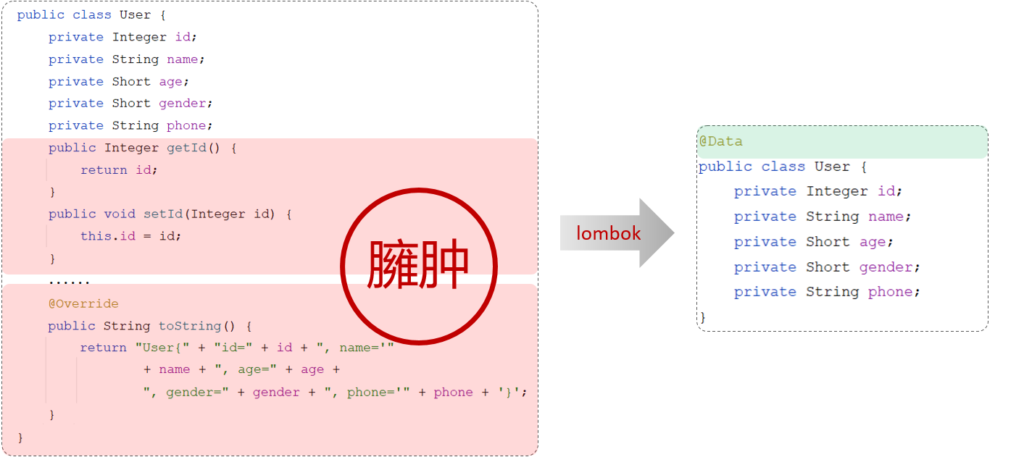
通过注解的形式自动生成构造器、getter/setter、equals、hashcode、toString等方法,并可以自动化生成日志变量,简化java开发、提高效率。
| 注解 | 作用 |
|---|---|
| @Getter/@Setter | 为所有的属性提供get/set方法 |
| @ToString | 会给类自动生成易阅读的 toString 方法 |
| @EqualsAndHashCode | 根据类所拥有的非静态字段自动重写 equals 方法和 hashCode 方法 |
| @Data | 提供了更综合的生成代码功能(@Getter + @Setter + @ToString + @EqualsAndHashCode) |
| @NoArgsConstructor | 为实体类生成无参的构造器方法 |
| @AllArgsConstructor | 为实体类生成除了static修饰的字段之外带有各参数的构造器方法。 |
使用
第1步:在pom.xml文件中引入依赖
<!-- 在springboot的父工程中,已经集成了lombok并指定了版本号,故当前引入依赖时不需要指定version -->
<dependency>
<groupId>org.projectlombok</groupId>
<artifactId>lombok</artifactId>
</dependency>第2步:在实体类上添加注解
import lombok.Data;
@Data
public class User {
private Integer id;
private String name;
private Short age;
private Short gender;
private String phone;
}在实体类上添加了@Data注解,那么这个类在编译时期,就会生成getter/setter、equals、hashcode、toString等方法。在 target 目录的 classes 目录下,找到实体类对应的包,对应的 .class 文件。
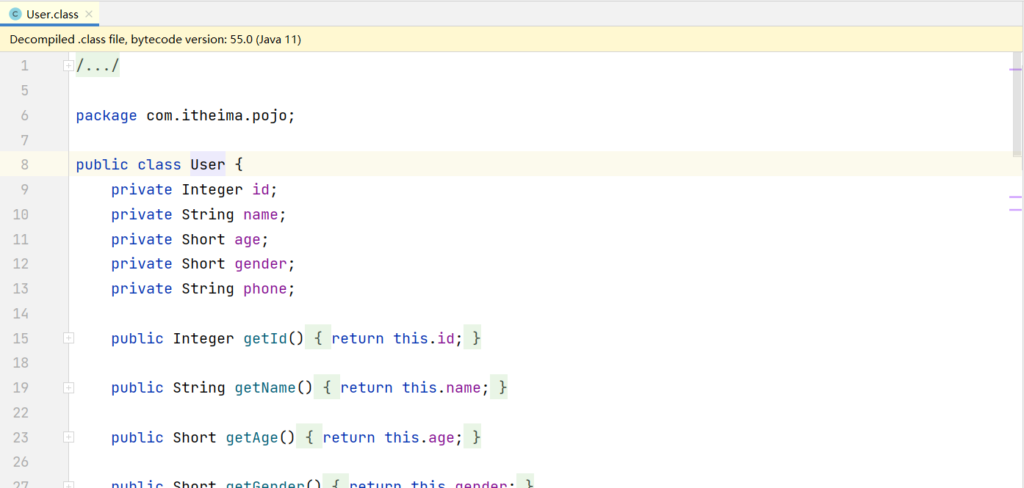
说明:@Data注解中不包含全参构造方法,通常在实体类上,还会添加上:全参构造、无参构造
import lombok.Data;
@Data //getter方法、setter方法、toString方法、hashCode方法、equals方法
@NoArgsConstructor //无参构造
@AllArgsConstructor//全参构造
public class User {
private Integer id;
private String name;
private Short age;
private Short gender;
private String phone;
}Lombok的注意事项:
- Lombok会在编译时,会自动生成对应的java代码
- 在使用lombok时,还需要安装一个lombok的插件(新版本的IDEA中自带)
Mybatis基础操作
需求
需求说明:
- 根据资料中提供的《tlias智能学习辅助系统》页面原型及需求,完成员工管理的需求开发。
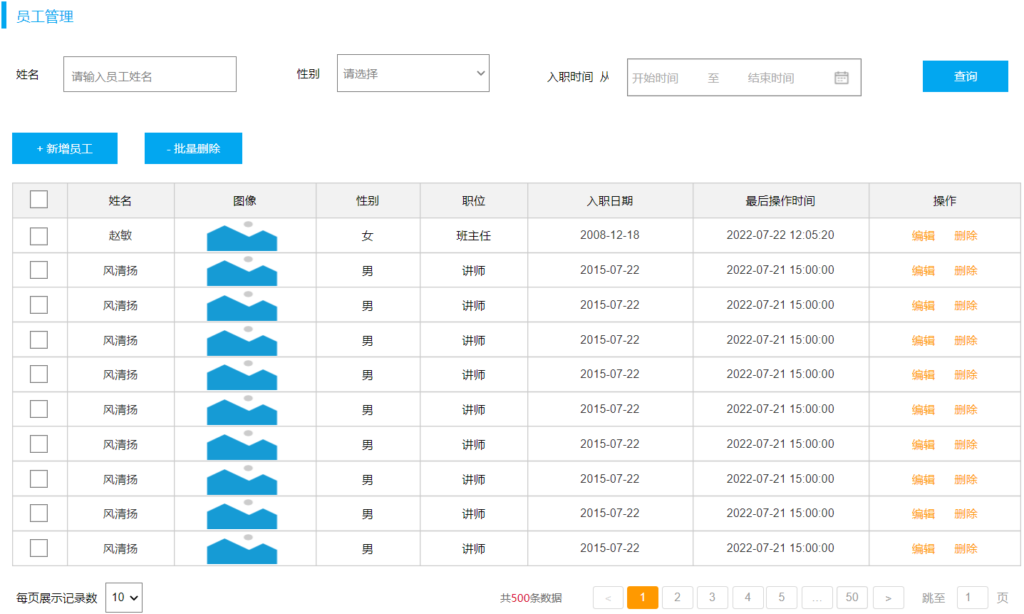
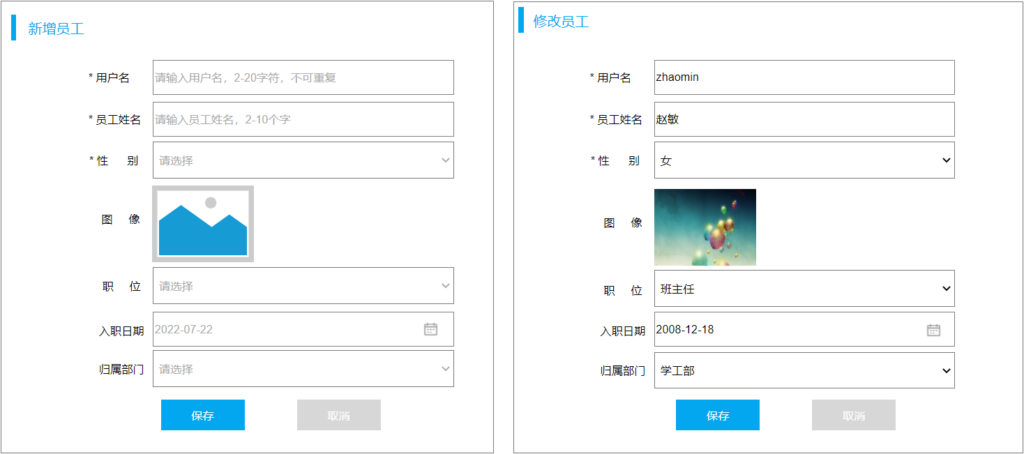

通过分析以上的页面原型和需求,我们确定了功能列表:
- 查询
- 根据主键ID查询
- 条件查询
- 新增
- 更新
- 删除
- 根据主键ID删除
- 根据主键ID批量删除
准备
实施前的准备工作:
- 准备数据库表
- 创建一个新的springboot工程,选择引入对应的起步依赖(mybatis、mysql驱动、lombok)
- application.properties中引入数据库连接信息
- 创建对应的实体类 Emp(实体类属性采用驼峰命名)
- 准备Mapper接口 EmpMapper
准备数据库表
-- 部门管理
create table dept
(
id int unsigned primary key auto_increment comment '主键ID',
name varchar(10) not null unique comment '部门名称',
create_time datetime not null comment '创建时间',
update_time datetime not null comment '修改时间'
) comment '部门表';
-- 部门表测试数据
insert into dept (id, name, create_time, update_time)
values (1, '学工部', now(), now()),
(2, '教研部', now(), now()),
(3, '咨询部', now(), now()),
(4, '就业部', now(), now()),
(5, '人事部', now(), now());
-- 员工管理
create tableemp
(
id int unsigned primary key auto_increment comment 'ID',
username varchar(20) not null unique comment '用户名',
password varchar(32) default '123456' comment '密码',
name varchar(10) not null comment '姓名',
gender tinyint unsigned not null comment '性别, 说明: 1 男, 2 女',
image varchar(300) comment '图像',
job tinyint unsigned comment '职位, 说明: 1 班主任,2 讲师, 3 学工主管, 4 教研主管, 5 咨询师',
entrydate date comment '入职时间',
dept_id int unsigned comment '部门ID',
create_time datetime not null comment '创建时间',
update_time datetime not null comment '修改时间'
) comment '员工表';
-- 员工表测试数据
INSERT INTO emp (id, username, password, name, gender, image, job, entrydate, dept_id, create_time, update_time)
VALUES
(1, 'jinyong', '123456', '金庸', 1, '1.jpg', 4, '2000-01-01', 2, now(), now()),
(2, 'zhangwuji', '123456', '张无忌', 1, '2.jpg', 2, '2015-01-01', 2, now(), now()),
(3, 'yangxiao', '123456', '杨逍', 1, '3.jpg', 2, '2008-05-01', 2, now(), now()),
(4, 'weiyixiao', '123456', '韦一笑', 1, '4.jpg', 2, '2007-01-01', 2, now(), now()),
(5, 'changyuchun', '123456', '常遇春', 1, '5.jpg', 2, '2012-12-05', 2, now(), now()),
(6, 'xiaozhao', '123456', '小昭', 2, '6.jpg', 3, '2013-09-05', 1, now(), now()),
(7, 'jixiaofu', '123456', '纪晓芙', 2, '7.jpg', 1, '2005-08-01', 1, now(), now()),
(8, 'zhouzhiruo', '123456', '周芷若', 2, '8.jpg', 1, '2014-11-09', 1, now(), now()),
(9, 'dingminjun', '123456', '丁敏君', 2, '9.jpg', 1, '2011-03-11', 1, now(), now()),
(10, 'zhaomin', '123456', '赵敏', 2, '10.jpg', 1, '2013-09-05', 1, now(), now()),
(11, 'luzhangke', '123456', '鹿杖客', 1, '11.jpg', 5, '2007-02-01', 3, now(), now()),
(12, 'hebiweng', '123456', '鹤笔翁', 1, '12.jpg', 5, '2008-08-18', 3, now(), now()),
(13, 'fangdongbai', '123456', '方东白', 1, '13.jpg', 5, '2012-11-01', 3, now(), now()),
(14, 'zhangsanfeng', '123456', '张三丰', 1, '14.jpg', 2, '2002-08-01', 2, now(), now()),
(15, 'yulianzhou', '123456', '俞莲舟', 1, '15.jpg', 2, '2011-05-01', 2, now(), now()),
(16, 'songyuanqiao', '123456', '宋远桥', 1, '16.jpg', 2, '2010-01-01', 2, now(), now()),
(17, 'chenyouliang', '123456', '陈友谅', 1, '17.jpg', NULL, '2015-03-21', NULL, now(), now());完成准备操作后,项目工程结构目录如下
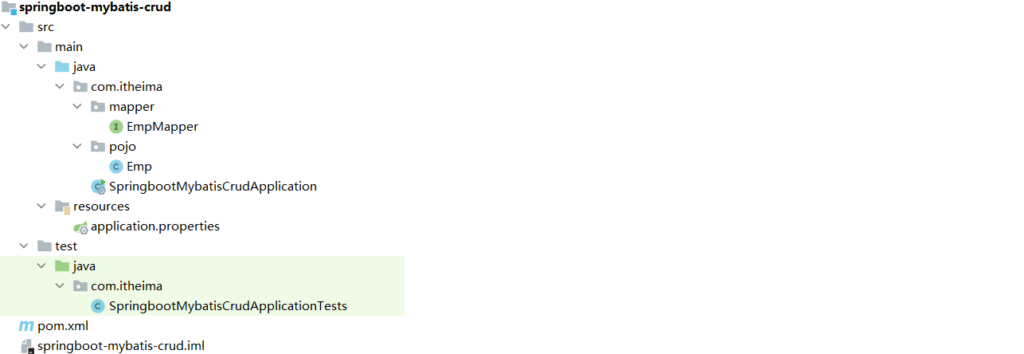
删除
功能实现

当我们点击后面的”删除”按钮时,前端页面会给服务端传递一个参数,也就是该行数据的ID。 我们接收到ID后,根据ID删除数据即可。
功能:根据主键删除数据
- SQL语句
-- 删除id=17的数据
delete from emp where id = 17;- 接口方法
@Mapper
public interface EmpMapper {
//@Delete("delete from emp where id = 17")
//public void delete();
//以上delete操作的SQL语句中的id值写成固定的17,就表示只能删除id=17的用户数据
//SQL语句中的id值不能写成固定数值,需要变为动态的数值
//解决方案:在delete方法中添加一个参数(用户id),将方法中的参数,传给SQL语句
/**
* 根据id删除数据
* @param id 用户id
*/
@Delete("delete from emp where id = #{id}")//使用#{key}方式获取方法中的参数值
public void delete(Integer id);
}@Delete注解:用于编写delete操作的SQL语句
如果mapper接口方法形参只有一个普通类型的参数,#{…} 里面的属性名可以随便写,如:#{id}、#{value}。但是建议保持与实体类字段名一致。
- 测试
- 在单元测试类中通过@Autowired注解注入EmpMapper类型对象
@SpringBootTest
class SpringbootMybatisCrudApplicationTests {
@Autowired //从Spring的IOC容器中,获取类型是EmpMapper的对象并注入
private EmpMapper empMapper;
@Test
public void testDel(){
//调用删除方法
empMapper.delete(16);
}
}日志输入
在Mybatis当中我们可以借助日志,查看到sql语句的执行、执行传递的参数以及执行结果。具体操作如下:
- 打开application.properties文件
- 开启mybatis的日志,并指定输出到控制台
#指定mybatis输出日志的位置, 输出控制台
mybatis.configuration.log-impl=org.apache.ibatis.logging.stdout.StdOutImpl开启日志之后,我们再次运行单元测试,可以看到在控制台中,输出了以下的SQL语句信息:

但是我们发现输出的SQL语句:delete from emp where id = ?,我们输入的参数16并没有在后面拼接,id的值是使用?进行占位。那这种SQL语句我们称为预编译SQL。
预编译SQL
预编译SQL有两个优势:
- 性能更高
- 更安全(防止SQL注入)

性能更高:预编译SQL,编译一次之后会将编译后的SQL语句缓存起来,后面再次执行这条语句时,不会再次编译。(只是输入的参数不同)
更安全(防止SQL注入):将敏感字进行转义,保障SQL的安全性。
SQL注入
SQL注入:是通过操作输入的数据来修改事先定义好的SQL语句,以达到执行代码对服务器进行攻击的方法。由于没有对用户输入进行充分检查,而SQL又是拼接而成,在用户输入参数时,在参数中添加一些SQL关键字,达到改变SQL运行结果的目的,也可以完成恶意攻击。
例如在某些网站登录,密码输入 ' or '1'='1 ,即使数据库中没有这种密码数据,也能登录成功。以上操作为什么能够登录成功呢?
- 由于没有对用户输入内容进行充分检查,而SQL又是字符串拼接方式而成,在用户输入参数时,在参数中添加一些SQL关键字,达到改变SQL运行结果的目的,从而完成恶意攻击。
- 用户在页面提交数据的时候人为的添加一些特殊字符,使得sql语句的结构发生了变化,最终可以在没有用户名或者密码的情况下进行登录。
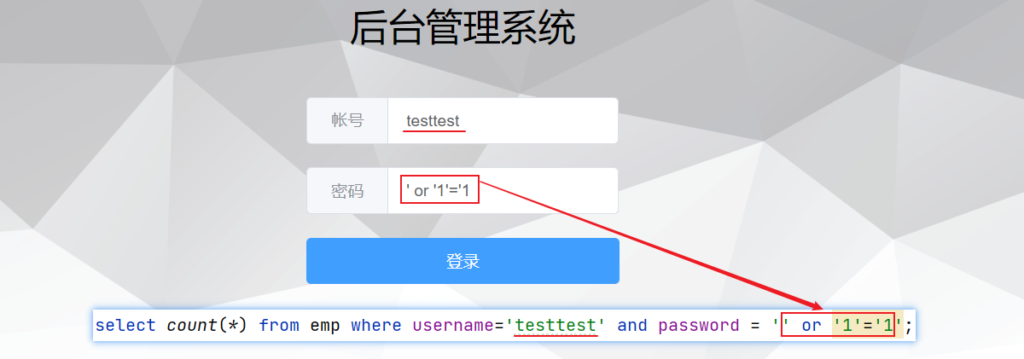
这种情况常常是因为使用了参数占位符 &{…} ,而使用 #{…}则不会有这种问题。
参数占位符
在Mybatis中提供的参数占位符有两种:${…} 、#{…}
- #{…}
- 执行SQL时,会将#{…}替换为?,生成预编译SQL,会自动设置参数值
- 使用时机:参数传递,都使用#{…}·
- ${…}
- 拼接SQL。直接将参数拼接在SQL语句中,存在SQL注入问题
- 使用时机:如果对表名、列表进行动态设置时使用
注:在项目开发中,建议使用 #{…},生成预编译SQL,防止SQL注入安全。
新增

SQL语句:
insert into emp(username, name, gender, image, job, entrydate, dept_id, create_time, update_time) values ('songyuanqiao','宋远桥',1,'1.jpg',2,'2012-10-09',2,'2022-10-01 10:00:00','2022-10-01 10:00:00');接口方法:
@Mapper
public interface EmpMapper {
@Insert("insert into emp(username, name, gender, image, job, entrydate, dept_id, create_time, update_time) values (#{username}, #{name}, #{gender}, #{image}, #{job}, #{entrydate}, #{deptId}, #{createTime}, #{updateTime})")
public void insert(Emp emp);
}说明:#{…} 里面写的名称是对象的属性名
测试类:
@SpringBootTest
class SpringbootMybatisCrudApplicationTests {
@Autowired
private EmpMapper empMapper;
@Test
public void testInsert(){
//创建员工对象
Emp emp = new Emp();
emp.setUsername("tom");
emp.setName("汤姆");
emp.setImage("1.jpg");
emp.setGender((short)1);
emp.setJob((short)1);
emp.setEntrydate(LocalDate.of(2000,1,1));
emp.setCreateTime(LocalDateTime.now());
emp.setUpdateTime(LocalDateTime.now());
emp.setDeptId(1);
//调用添加方法
empMapper.insert(emp);
}
}
主键返回
概念:在数据添加成功后,需要获取插入数据库数据的主键。
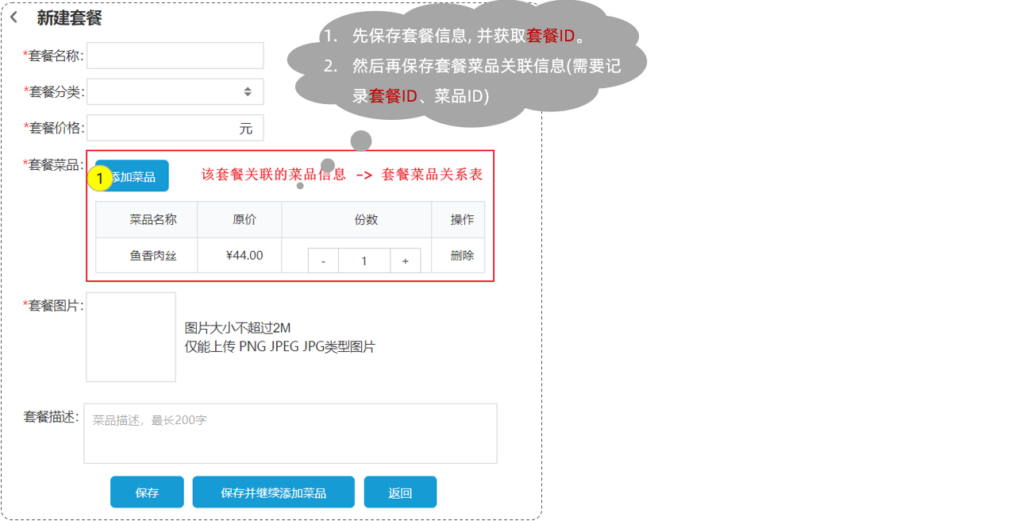
例如套餐和菜品的多对多关系,显然需要一张套餐菜品中间表来维护关系。那么,在添加套餐数据时,还需要维护套餐菜品关系表数据。
也就是说,一旦添加新的套餐,套餐和菜品的对应关系需要保存到中间表中。而中间表当中有两个外键字段,一个是菜品的ID,还有一个就是套餐的ID。因为我们添加的是套餐,所以套餐id自然成为了所需的主键,要保存在中间表中,则必然要拿到这个主键id。获取主键id的操作即主键返回。
那要如何实现在插入数据之后返回所插入行的主键值呢?
- 默认情况下,执行插入操作时,是不会主键值返回的。如果我们想要拿到主键值,需要在Mapper接口中的方法上添加一个Options注解,并在注解中指定属性useGeneratedKeys=true和keyProperty=”实体类属性名”
主键返回代码实现:
@Mapper
public interface EmpMapper {
//会自动将生成的主键值,赋值给emp对象的id属性
@Options(useGeneratedKeys = true,keyProperty = "id")
@Insert("insert into emp(username, name, gender, image, job, entrydate, dept_id, create_time, update_time) values (#{username}, #{name}, #{gender}, #{image}, #{job}, #{entrydate}, #{deptId}, #{createTime}, #{updateTime})")
public void insert(Emp emp);
}更新
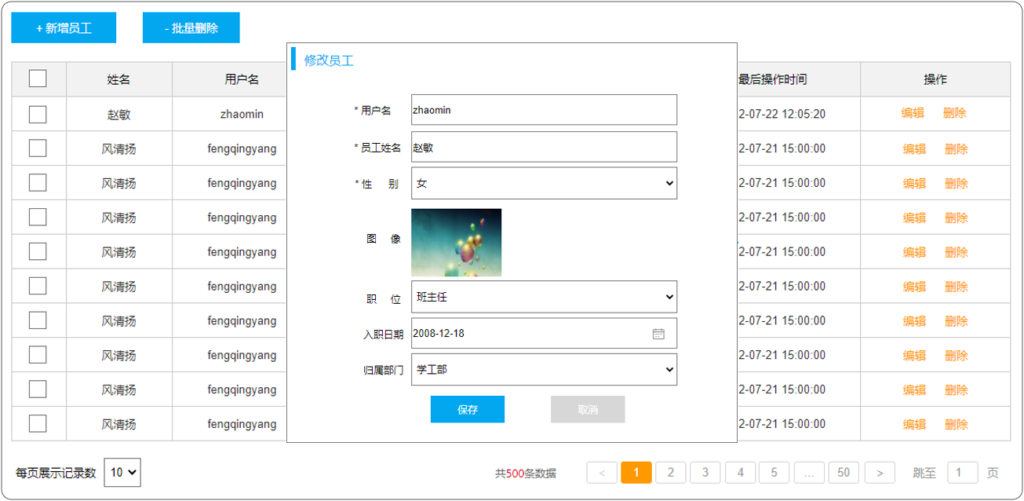
SQL语句:
update emp set username = 'linghushaoxia', name = '令狐少侠', gender = 1 , image = '1.jpg' , job = 2, entrydate = '2012-01-01', dept_id = 2, update_time = '2022-10-01 12:12:12' where id = 18;接口方法:
@Mapper
public interface EmpMapper {
/**
* 根据id修改员工信息
* @param emp
*/
@Update("update emp set username=#{username}, name=#{name}, gender=#{gender}, image=#{image}, job=#{job}, entrydate=#{entrydate}, dept_id=#{deptId}, update_time=#{updateTime} where id=#{id}")
public void update(Emp emp);
}测试类:
@SpringBootTest
class SpringbootMybatisCrudApplicationTests {
@Autowired
private EmpMapper empMapper;
@Test
public void testUpdate(){
//要修改的员工信息
Emp emp = new Emp();
emp.setId(23);
emp.setUsername("songdaxia");
emp.setPassword(null);
emp.setName("老宋");
emp.setImage("2.jpg");
emp.setGender((short)1);
emp.setJob((short)2);
emp.setEntrydate(LocalDate.of(2012,1,1));
emp.setCreateTime(null);
emp.setUpdateTime(LocalDateTime.now());
emp.setDeptId(2);
//调用方法,修改员工数据
empMapper.update(emp);
}
}查询
根据id查询
在员工管理的页面中,当我们进行更新数据时,会点击 “编辑” 按钮,然后此时会发送一个请求到服务端,会根据Id查询该员工信息,并将员工数据回显在页面上。
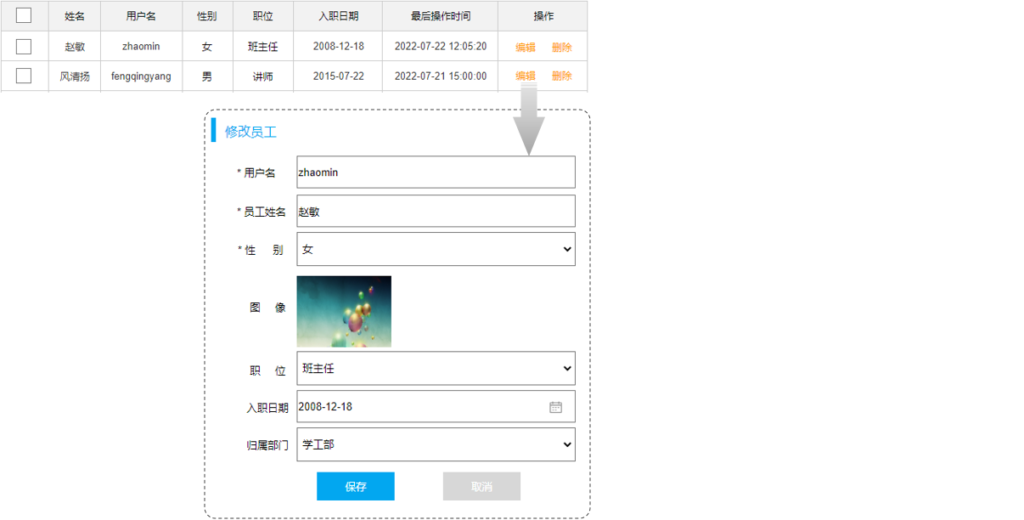
SQL语句:
select id, username, password, name, gender, image, job, entrydate, dept_id, create_time, update_time from emp;接口方法:
@Mapper
public interface EmpMapper {
@Select("select id, username, password, name, gender, image, job, entrydate, dept_id, create_time, update_time from emp where id=#{id}")
public Emp getById(Integer id);
}测试类:
@SpringBootTest
class SpringbootMybatisCrudApplicationTests {
@Autowired
private EmpMapper empMapper;
@Test
public void testGetById(){
Emp emp = empMapper.getById(1);
System.out.println(emp);
}
}而在测试的过程中,我们会发现有几个字段(deptId、createTime、updateTime)是没有数据值的

数据封装
我们看到查询返回的结果中大部分字段是有值的,但是deptId,createTime,updateTime这几个字段是没有值的,而数据库中是有对应的字段值的,这是为什么呢?
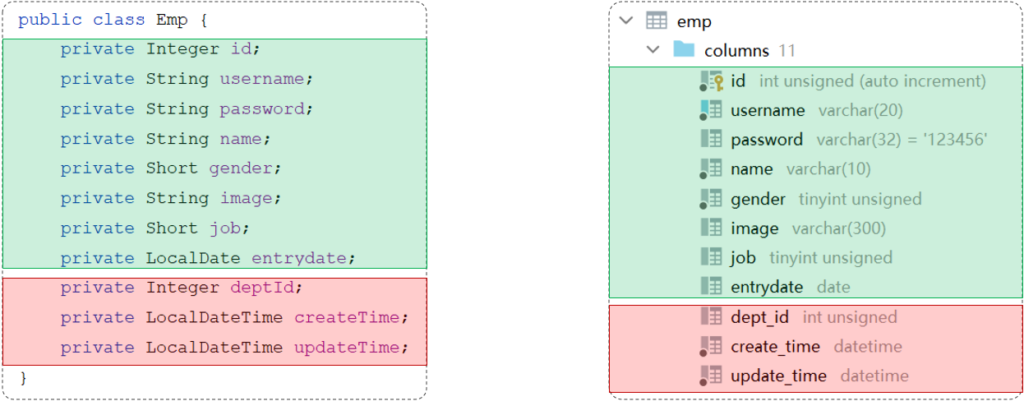
原因如下:
- 实体类属性名和数据库表查询返回的字段名一致,mybatis会自动封装。
- 如果实体类属性名和数据库表查询返回的字段名不一致,不能自动封装。
解决方案:
- 起别名
- 结果映射
- 开启驼峰命名
起别名:在SQL语句中,对不一样的列名起别名,别名和实体类属性名一样
@Select("select id, username, password, name, gender, image, job, entrydate, " +
"dept_id AS deptId, create_time AS createTime, update_time AS updateTime " +
"from emp " +
"where id=#{id}") // as可省略
public Emp getById(Integer id);手动结果映射:通过 @Results及@Result 进行手动结果映射
@Results({@Result(column = "dept_id", property = "deptId"),
@Result(column = "create_time", property = "createTime"),
@Result(column = "update_time", property = "updateTime")})
@Select("select id, username, password, name, gender, image, job, entrydate, dept_id, create_time, update_time from emp where id=#{id}")
public Emp getById(Integer id);开启驼峰命名(推荐):如果字段名与属性名符合驼峰命名规则,mybatis会自动通过驼峰命名规则映射
驼峰命名规则: abc_xyz => abcXyz
- 表中字段名:abc_xyz
- 类中属性名:abcXyz
# 在application.properties中添加:
mybatis.configuration.map-underscore-to-camel-case=true要使用驼峰命名前提是 实体类的属性 与 数据库表中的字段名 严格遵守驼峰命名。
条件查询
在员工管理的列表页面中,我们需要根据条件查询员工信息,查询条件包括:姓名、性别、入职时间。
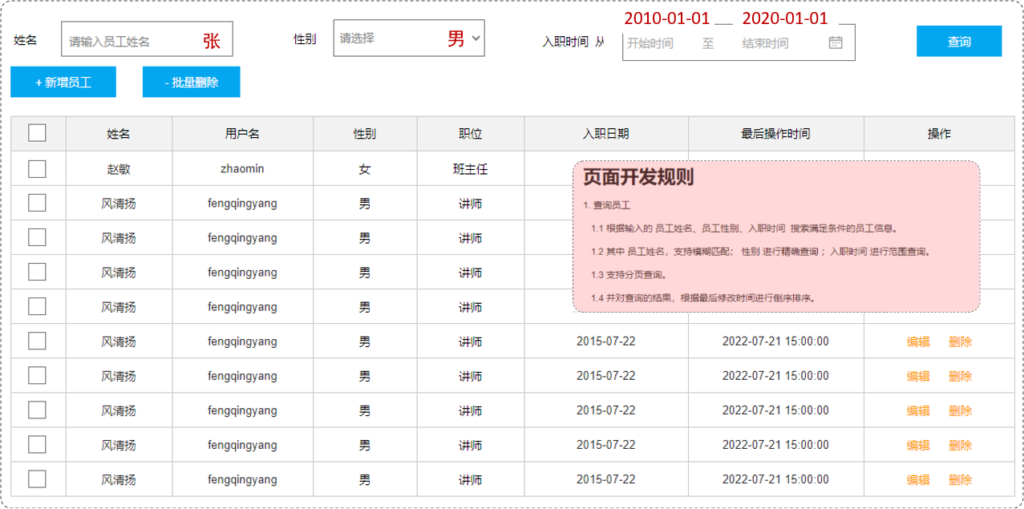
通过页面原型以及需求描述我们要实现的查询:
- 姓名:要求支持模糊匹配
- 性别:要求精确匹配
- 入职时间:要求进行范围查询
- 根据最后修改时间进行降序排序
SQL语句:
select id, username, password, name, gender, image, job, entrydate, dept_id, create_time, update_time
from emp
where name like '%张%'
and gender = 1
and entrydate between '2010-01-01' and '2020-01-01 '
order by update_time desc;接口方法:
- 方式一
@Mapper
public interface EmpMapper {
@Select("select * from emp " +
"where name like '%${name}%' " +
"and gender = #{gender} " +
"and entrydate between #{begin} and #{end} " +
"order by update_time desc")
public List<Emp> list(String name, Short gender, LocalDate begin, LocalDate end);
}以上方式注意事项:
- 方法中的形参名和SQL语句中的参数占位符名保持一致
- 模糊查询使用${…}进行字符串拼接,这种方式由于是字符串拼接,并不是预编译的形式,所以效率不高、且存在sql注入风险。
- 方式二(解决SQL注入风险)
- 使用MySQL提供的字符串拼接函数:concat(‘%’ , ‘关键字’ , ‘%’)
@Mapper
public interface EmpMapper {
@Select("select * from emp " +
"where name like concat('%',#{name},'%') " +
"and gender = #{gender} " +
"and entrydate between #{begin} and #{end} " +
"order by update_time desc")
public List<Emp> list(String name, Short gender, LocalDate begin, LocalDate end);
}执行结果:生成的SQL都是预编译的SQL语句(性能高、安全)

参数名说明
在上面我们所编写的条件查询功能中,我们需要保证接口中方法的形参名和SQL语句中的参数占位符名相同。
当方法中的形参名和SQL语句中的占位符参数名不相同时,就会出现以下问题:
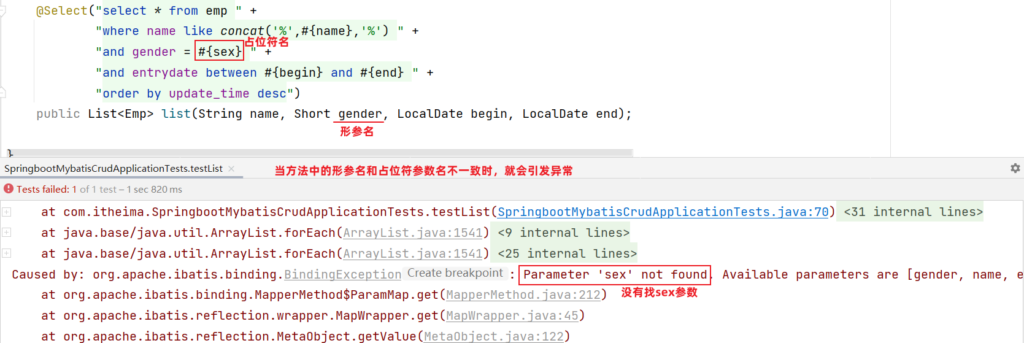
参数名在不同的SpringBoot版本中,处理方案还不同:
- 在springBoot的2.x版本(保证参数名一致)

springBoot的父工程对compiler编译插件进行了默认的参数parameters配置,使得在编译时,会在生成的字节码文件中保留原方法形参的名称,所以#{…}里面可以直接通过形参名获取对应的值。

- 在springBoot的1.x版本/单独使用mybatis(使用@Param注解来指定SQL语句中的参数名)

在编译时,生成的字节码文件当中,不会保留Mapper接口中方法的形参名称,而是使用var1、var2、…这样的形参名字,此时要获取参数值时,就要通过@Param注解来指定SQL语句中的参数名。

Mybatis的XML配置文件
Mybatis的开发有两种方式:
- 注解
- XML
XML配置文件规范
使用Mybatis的注解方式,主要是来完成一些简单的增删改查功能。如果需要实现复杂的SQL功能,建议使用XML来配置映射语句,也就是将SQL语句写在XML配置文件中。
在Mybatis中使用XML映射文件方式开发,需要符合一定的规范:
- XML映射文件的名称与Mapper接口名称一致,并且将XML映射文件和Mapper接口放置在相同包下(同包同名)
- XML映射文件的namespace属性为Mapper接口全限定名一致
- XML映射文件中sql语句的id与Mapper接口中的方法名一致,并保持返回类型一致。

注:resultType属性,指的是查询返回的单条记录所封装的类型。
XML配置文件实现
第1步:创建XML映射文件
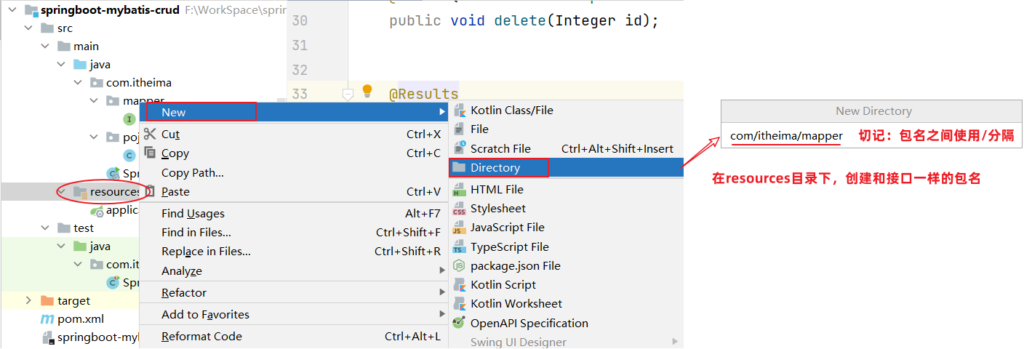


第2步:编写XML映射文件
xml映射文件中的dtd约束,直接从mybatis中文网复制即可
<?xml version="1.0" encoding="UTF-8" ?>
<!DOCTYPE mapper
PUBLIC "-//mybatis.org//DTD Mapper 3.0//EN"
"https://mybatis.org/dtd/mybatis-3-mapper.dtd">
<mapper namespace="">
</mapper>配置:XML映射文件的namespace属性为Mapper接口全限定名
<?xml version="1.0" encoding="UTF-8" ?>
<!DOCTYPE mapper
PUBLIC "-//mybatis.org//DTD Mapper 3.0//EN"
"https://mybatis.org/dtd/mybatis-3-mapper.dtd">
<mapper namespace="com.itheima.mapper.EmpMapper">
</mapper>配置:XML映射文件中sql语句的id与Mapper接口中的方法名一致,并保持返回类型一致
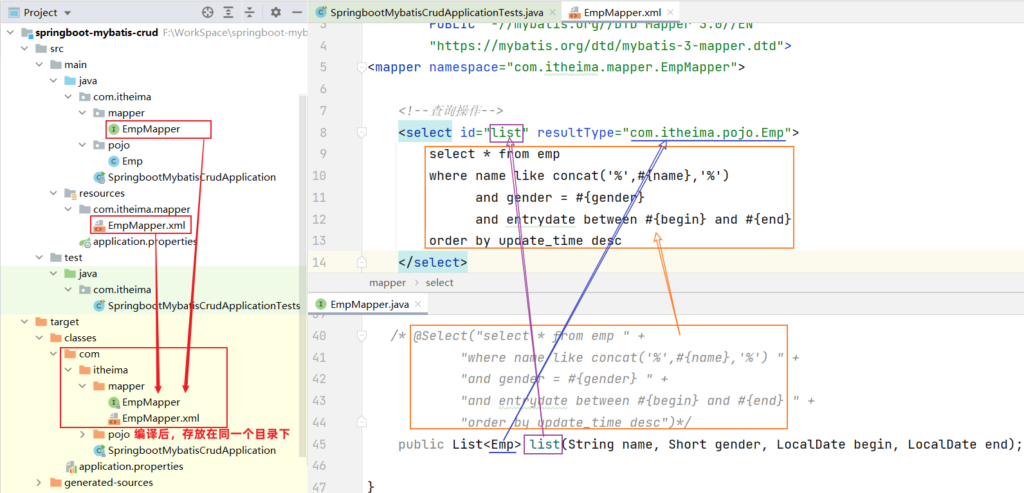
<?xml version="1.0" encoding="UTF-8" ?>
<!DOCTYPE mapper
PUBLIC "-//mybatis.org//DTD Mapper 3.0//EN"
"https://mybatis.org/dtd/mybatis-3-mapper.dtd">
<mapper namespace="com.itheima.mapper.EmpMapper">
<!--查询操作-->
<select id="list" resultType="com.itheima.pojo.Emp">
select * from emp
where name like concat('%',#{name},'%')
and gender = #{gender}
and entrydate between #{begin} and #{end}
order by update_time desc
</select>
</mapper>结论:使用Mybatis的注解,主要是来完成一些简单的增删改查功能。如果需要实现复杂的SQL功能,建议使用XML来配置映射语句。
Mybatis动态SQL
介绍
在页面原型中,列表上方的条件是动态的,是可以不传递的,也可以只传递其中的1个或者2个或者全部。
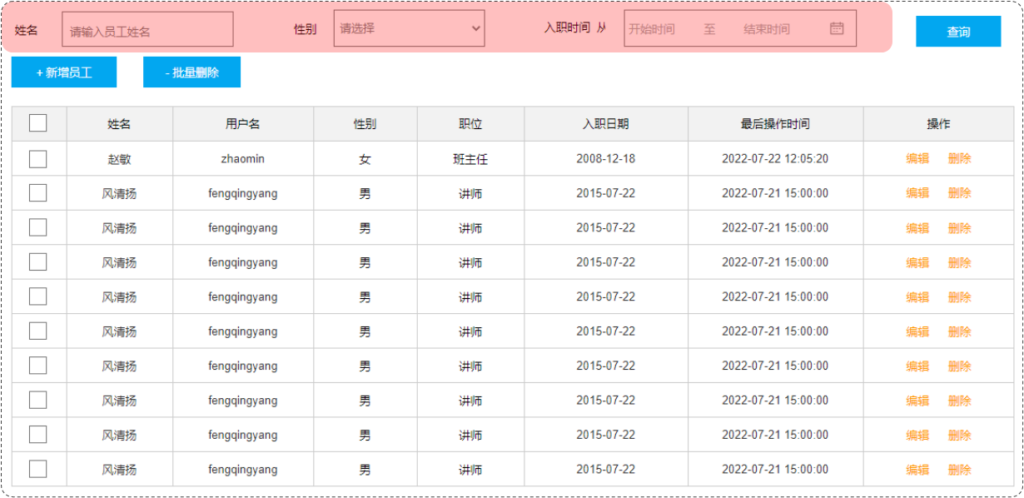
而在我们刚才编写的SQL语句中,我们会看到,我们将三个条件直接写死了。 如果页面只传递了参数姓名name 字段,其他两个字段 性别 和 入职时间 没有传递,那么这两个参数的值就是null。
此时,执行的SQL语句为:

这个查询结果是不正确的。正确的做法应该是:传递了参数,再组装这个查询条件;如果没有传递参数,就不应该组装这个查询条件。
比如:姓名输入了”张”,,性别选择了”男”,则对应的SQL为:
select * from emp where name like '%张%' and gender = 1 order by update_time desc;SQL语句会随着用户的输入或外部条件的变化而变化,我们称为:动态SQL。
动态SQL-if
<if>:用于判断条件是否成立。使用test属性进行条件判断,如果条件为true,则拼接SQL。
<if test="条件表达式">
要拼接的sql语句
</if>条件查询
示例:把SQL语句改造为动态SQL方式
- 原有的SQL语句
<select id="list" resultType="com.itheima.pojo.Emp">
select * from emp
where name like concat('%',#{name},'%')
and gender = #{gender}
and entrydate between #{begin} and #{end}
order by update_time desc
</select>- 动态SQL语句
<select id="list" resultType="com.itheima.pojo.Emp">
select * from emp
where
<if test="name != null">
name like concat('%',#{name},'%')
</if>
<if test="gender != null">
and gender = #{gender}
</if>
<if test="begin != null and end != null">
and entrydate between #{begin} and #{end}
</if>
order by update_time desc
</select>测试方法:
@Test
public void testList(){
//性别数据为null、开始时间和结束时间也为null
List<Emp> list = empMapper.list("张", null, null, null);
for(Emp emp : list){
System.out.println(emp);
}
}
接下来修改参数,再次测试:
@Test
public void testList(){
//姓名为null
List<Emp> list = empMapper.list(null, (short)1, null, null);
for(Emp emp : list){
System.out.println(emp);
}
}

再次修改参数,进行测试:
@Test
public void testList(){
//传递的数据全部为null
List<Emp> list = empMapper.list(null, null, null, null);
for(Emp emp : list){
System.out.println(emp);
}
}
以上问题的解决方案:使用<where>标签代替SQL语句中的where关键字
<where>只会在子元素有内容的情况下才插入where子句,而且会自动去除子句的开头的AND或OR
<select id="list" resultType="com.itheima.pojo.Emp">
select * from emp
<where>
<!-- if做为where标签的子元素 -->
<if test="name != null">
and name like concat('%',#{name},'%')
</if>
<if test="gender != null">
and gender = #{gender}
</if>
<if test="begin != null and end != null">
and entrydate between #{begin} and #{end}
</if>
</where>
order by update_time desc
</select>使用刚才出错的测试方法:
@Test
public void testList(){
//只有性别
List<Emp> list = empMapper.list(null, (short)1, null, null);
for(Emp emp : list){
System.out.println(emp);
}
}
更新员工
案例:完善更新员工功能,修改为动态更新员工数据信息
- 动态更新员工信息,如果更新时传递有值,则更新;如果更新时没有传递值,则不更新
- 解决方案:动态SQL
修改Mapper接口:
@Mapper
public interface EmpMapper {
//删除@Update注解编写的SQL语句
//update操作的SQL语句编写在Mapper映射文件中
public void update(Emp emp);
}修改Mapper映射文件:
<?xml version="1.0" encoding="UTF-8" ?>
<!DOCTYPE mapper
PUBLIC "-//mybatis.org//DTD Mapper 3.0//EN"
"https://mybatis.org/dtd/mybatis-3-mapper.dtd">
<mapper namespace="com.itheima.mapper.EmpMapper">
<!--更新操作-->
<update id="update">
update emp
set
<if test="username != null">
username=#{username},
</if>
<if test="name != null">
name=#{name},
</if>
<if test="gender != null">
gender=#{gender},
</if>
<if test="image != null">
image=#{image},
</if>
<if test="job != null">
job=#{job},
</if>
<if test="entrydate != null">
entrydate=#{entrydate},
</if>
<if test="deptId != null">
dept_id=#{deptId},
</if>
<if test="updateTime != null">
update_time=#{updateTime}
</if>
where id=#{id}
</update>
</mapper>测试方法:
@Test
public void testUpdate2(){
//要修改的员工信息
Emp emp = new Emp();
emp.setId(20);
emp.setUsername("Tom111");
emp.setName("汤姆111");
emp.setUpdateTime(LocalDateTime.now());
//调用方法,修改员工数据
empMapper.update(emp);
}
再次修改测试方法,观察SQL语句执行情况:
@Test
public void testUpdate2(){
//要修改的员工信息
Emp emp = new Emp();
emp.setId(20);
emp.setUsername("Tom222");
//调用方法,修改员工数据
empMapper.update(emp);
}
以上问题的解决方案:使用<set>标签代替SQL语句中的set关键字
<set>:动态的在SQL语句中插入set关键字,并会删掉额外的逗号。(用于update语句中)
<?xml version="1.0" encoding="UTF-8" ?>
<!DOCTYPE mapper
PUBLIC "-//mybatis.org//DTD Mapper 3.0//EN"
"https://mybatis.org/dtd/mybatis-3-mapper.dtd">
<mapper namespace="com.itheima.mapper.EmpMapper">
<!--更新操作-->
<update id="update">
update emp
<!-- 使用set标签,代替update语句中的set关键字 -->
<set>
<if test="username != null">
username=#{username},
</if>
<if test="name != null">
name=#{name},
</if>
<if test="gender != null">
gender=#{gender},
</if>
<if test="image != null">
image=#{image},
</if>
<if test="job != null">
job=#{job},
</if>
<if test="entrydate != null">
entrydate=#{entrydate},
</if>
<if test="deptId != null">
dept_id=#{deptId},
</if>
<if test="updateTime != null">
update_time=#{updateTime}
</if>
</set>
where id=#{id}
</update>
</mapper>
小结
<if>- 用于判断条件是否成立,如果条件为true,则拼接SQL
- 形式: <if test=”name != null”> … </if>
<where>- where元素只会在子元素有内容的情况下才插入where子句,而且会自动去除子句的开头的AND或OR
<set>- 动态地在行首插入 SET 关键字,并会删掉额外的逗号。(用在update语句中)
动态SQL-foreach
案例:员工删除功能(既支持删除单条记录,又支持批量删除)

SQL语句:
delete from emp where id in (1,2,3);Mapper接口:
@Mapper
public interface EmpMapper {
//批量删除
public void deleteByIds(List<Integer> ids);
}XML映射文件:
- 使用
<foreach>遍历deleteByIds方法中传递的参数ids集合
<foreach collection="集合名称" item="集合遍历出来的元素/项" separator="每一次遍历使用的分隔符"
open="遍历开始前拼接的片段" close="遍历结束后拼接的片段">
</foreach><?xml version="1.0" encoding="UTF-8" ?>
<!DOCTYPE mapper
PUBLIC "-//mybatis.org//DTD Mapper 3.0//EN"
"https://mybatis.org/dtd/mybatis-3-mapper.dtd">
<mapper namespace="com.itheima.mapper.EmpMapper">
<!--删除操作-->
<delete id="deleteByIds">
delete from emp where id in
<foreach collection="ids" item="id" separator="," open="(" close=")">
#{id}
</foreach>
</delete>
</mapper> 

动态SQL-sql&include
问题分析:
- 在xml映射文件中配置的SQL,有时可能会存在很多重复的片段,此时就会存在很多冗余的代码
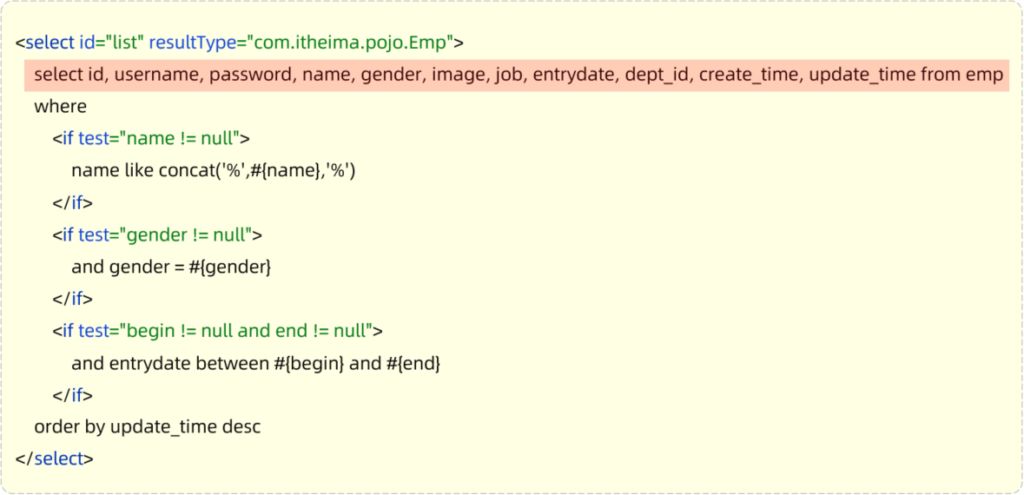
我们可以对重复的代码片段进行抽取,将其通过<sql>标签封装到一个SQL片段,然后再通过<include>标签进行引用。
<sql>:定义可重用的SQL片段<include>:通过属性refid,指定包含的SQL片段
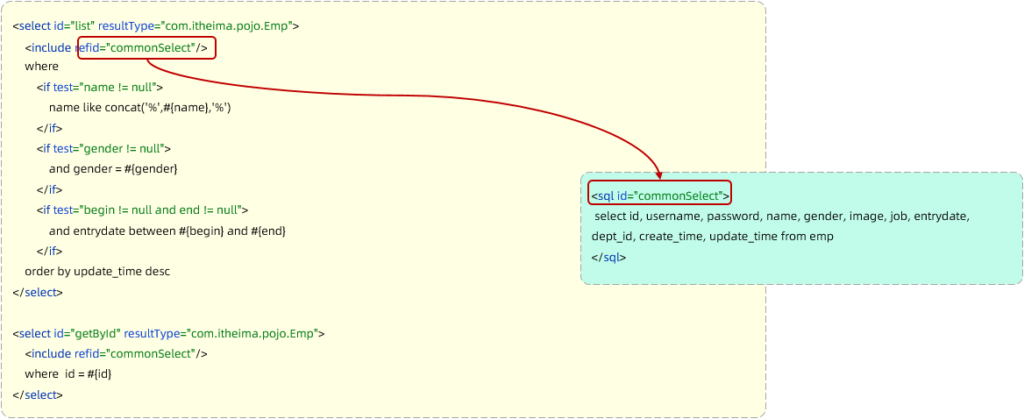
SQL片段: 抽取重复的代码
<sql id="commonSelect">
select id, username, password, name, gender, image, job, entrydate, dept_id, create_time, update_time from emp
</sql>然后通过<include> 标签在原来抽取的地方进行引用。操作如下:
<select id="list" resultType="com.itheima.pojo.Emp">
<include refid="commonSelect"/>
<where>
<if test="name != null">
name like concat('%',#{name},'%')
</if>
<if test="gender != null">
and gender = #{gender}
</if>
<if test="begin != null and end != null">
and entrydate between #{begin} and #{end}
</if>
</where>
order by update_time desc
</select>
